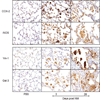Inflammatory mechanisms of pulmonary injury induced by mustards
- PMID: 26478570
- PMCID: PMC4753082
- DOI: 10.1016/j.toxlet.2015.10.011
Inflammatory mechanisms of pulmonary injury induced by mustards
Abstract
Exposure of humans and animals to vesicants, including sulfur mustard (SM) and nitrogen mustard (NM), causes severe and debilitating damage to the respiratory tract. Both acute and long term pathological consequences are observed in the lung following a single exposure to these vesicants. Evidence from our laboratories and others suggest that macrophages and the inflammatory mediators they release play an important role in mustard-induced lung injury. In this paper, the pathogenic effects of SM and NM on the lung are reviewed, along with the potential role of inflammatory macrophages and mediators they release in mustard-induced pulmonary toxicity.
Keywords: Lung injury; Pulmonary toxicity; TNFα; Vesicant; iNOS.
Copyright © 2015 Elsevier Ireland Ltd. All rights reserved.
Figures


Similar articles
-
Macrophages and inflammatory mediators in pulmonary injury induced by mustard vesicants.Ann N Y Acad Sci. 2016 Jun;1374(1):168-75. doi: 10.1111/nyas.13123. Epub 2016 Jun 28. Ann N Y Acad Sci. 2016. PMID: 27351588 Free PMC article. Review.
-
Protective role of spleen-derived macrophages in lung inflammation, injury, and fibrosis induced by nitrogen mustard.Am J Physiol Lung Cell Mol Physiol. 2015 Dec 15;309(12):L1487-98. doi: 10.1152/ajplung.00276.2015. Epub 2015 Oct 16. Am J Physiol Lung Cell Mol Physiol. 2015. PMID: 26475734 Free PMC article.
-
From the Cover: Catalytic Antioxidant Rescue of Inhaled Sulfur Mustard Toxicity.Toxicol Sci. 2016 Dec;154(2):341-353. doi: 10.1093/toxsci/kfw170. Epub 2016 Sep 7. Toxicol Sci. 2016. PMID: 27605419 Free PMC article.
-
Role of macrophage bioenergetics in N-acetylcysteine-mediated mitigation of lung injury and oxidative stress induced by nitrogen mustard.Toxicol Appl Pharmacol. 2024 Apr;485:116908. doi: 10.1016/j.taap.2024.116908. Epub 2024 Mar 19. Toxicol Appl Pharmacol. 2024. PMID: 38513841 Free PMC article.
-
Long-term Respiratory Effects of Mustard Vesicants.Toxicol Lett. 2020 Feb 1;319:168-174. doi: 10.1016/j.toxlet.2019.10.026. Epub 2019 Nov 4. Toxicol Lett. 2020. PMID: 31698045 Free PMC article. Review.
Cited by
-
Progressive Lung Injury, Inflammation, and Fibrosis in Rats Following Inhalation of Sulfur Mustard.Toxicol Sci. 2020 Dec 1;178(2):358-374. doi: 10.1093/toxsci/kfaa150. Toxicol Sci. 2020. PMID: 33002157 Free PMC article.
-
Targeting Tumor Necrosis Factor Alpha to Mitigate Lung Injury Induced by Mustard Vesicants and Radiation.Disaster Med Public Health Prep. 2023 Oct 18;17:e553. doi: 10.1017/dmp.2023.178. Disaster Med Public Health Prep. 2023. PMID: 37848400 Free PMC article. Review.
-
Macrophages and inflammatory mediators in pulmonary injury induced by mustard vesicants.Ann N Y Acad Sci. 2016 Jun;1374(1):168-75. doi: 10.1111/nyas.13123. Epub 2016 Jun 28. Ann N Y Acad Sci. 2016. PMID: 27351588 Free PMC article. Review.
-
The therapeutic effects of bone marrow-derived mesenchymal stromal cells in the acute lung injury induced by sulfur mustard.Stem Cell Res Ther. 2019 Mar 12;10(1):90. doi: 10.1186/s13287-019-1189-x. Stem Cell Res Ther. 2019. PMID: 30867053 Free PMC article.
-
MG53 attenuates nitrogen mustard-induced acute lung injury.J Cell Mol Med. 2022 Apr;26(7):1886-1895. doi: 10.1111/jcmm.16917. Epub 2022 Feb 24. J Cell Mol Med. 2022. PMID: 35199443 Free PMC article.
References
-
- Aggarwal BB. Signalling pathways of the TNF superfamily: a double-edged sword. Nat. Rev. Immunol. 2003;3:745–756. - PubMed
-
- Aghanouri R, Ghanei M, Aslani J, Keivani-Amine H, Rastegar F, Karkhane A. Fibrogenic cytokine levels in bronchoalveolar lavage aspirates 15 years after exposure to sulfur mustard. Am. J. Physiol. Lung Cell. Mol. Physiol. 2004;287:L1160–L1164. - PubMed
-
- Anderson DR, Taylor SL, Fetterer DP, Holmes WW. Evaluation of protease inhibitors and an antioxidant for treatment of sulfur mustard-induced toxic lung injury. Toxicology. 2009;263:41–46. - PubMed
-
- Arafa HM, Abdel-Wahab MH, El-Shafeey MF, Badary OA, Hamada FM. Anti-fibrotic effect of meloxicam in a murine lung fibrosis model. Eur. J. Pharmacol. 2007;564:181–189. - PubMed
-
- Balali-Mood M, Hefazi M. The pharmacology, toxicology, and medical treatment of sulphur mustard poisoning. Fundam. Clin. Pharmacol. 2005;19:297–315. - PubMed
Publication types
MeSH terms
Substances
Grants and funding
LinkOut - more resources
Full Text Sources
Other Literature Sources
Medical

